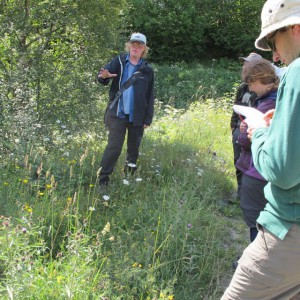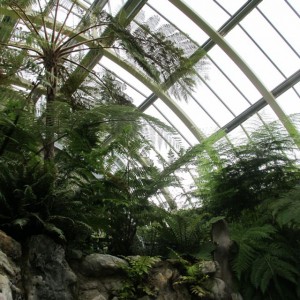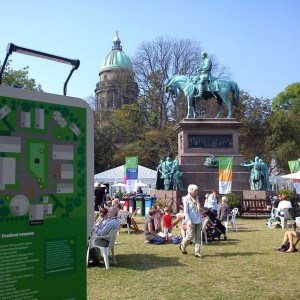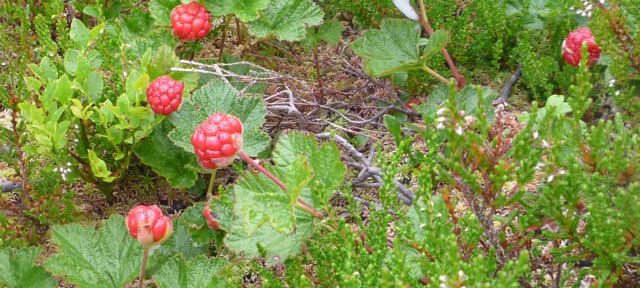
The city was cold with sea mist (which as a non-Scot I now know to call haar) when mentor Lindsay and I left very early for Grey Mare’s Tail. I was tired, having returned from a training course very late the night before – such is the life of a new apprentice. But I was prepared, or rather forewarned, for the rousing ascent up the path alongside Britain’s fifth-highest waterfall.
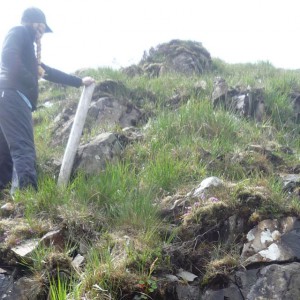
Locating quadrats in craggy spots. Not a task for vertigo sufferers, but good for admiring willows and pretty alpine species.
We met with Richard, the ranger of this NTS countryside property in the Southern Uplands, to continue a programme of monitoring. As at Ben Lawers, which I had visited in July, there are areas of the hills here fenced off to exclude animals. It is hoped that preventing grazing and browsing will allow the vegetation to recover in these ‘exclosures’, and there are surviving populations of rare species that motivate such action. The Oblong Woodsia, Woodsia ilvensis, perhaps the UK’s rarest fern species, persists in the less-accessible rocky places, as do other rarities like Black Alpine-sedge, Carex atrata, and Whortle-leaved Willow, Salix myrsinites.
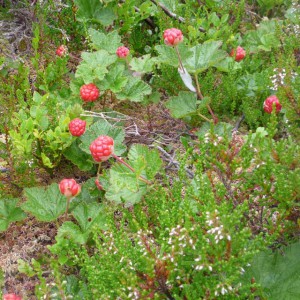
Cloudberries, Rubus chamaemorus, were a reward for hard hill work. Their flavour depends on who you ask: Lindsay describes them as somewhat tropical, like ‘Opal Fruits’, whereas Richard and I get hints of apple.
The past few weeks have been a festival of learning for me. I’ve been able to go away on some fascinating courses, packed full of information which I hope I’ve partially absorbed! I began with a trip to the Field Studies Council centre at Kindrogan for an NVC course with Ben Averis. The NVC, or National Vegetation Classification, is a system for naming habitat types found in the UK and is the basis of many botanical site surveys. When I begin to do survey work, it may be necessary for me to describe (with a fancy code, like U4 or CG11) the upland habitat types I’m finding fungi in!
Next, I ventured up to Aviemore for a a training workshop ran by the Mountain Woodland Project. Here I got to know the trees and shrubs of montane scrub, including Juniper, Juniperus communis, and Dwarf Birch, Betula nana. However, the main challenge of weekend were the montane willows. There are six species of these, all showing some degree of variation and hybridisation. Willows are oddly captivating, but their downright obtuseness means they’ll remain the expertise of just a few stubborn minds.
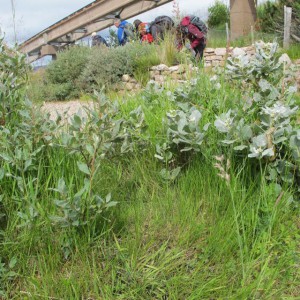
Downy willow, Salix lapponum, (left) and Woolly willow, S. lanata, (right) at the Cairngorm Mountain Garden.
August began at Benmore Botanic Garden for a pleasurable workshop in fern identification, organised by Plantlife and led by Heather McHaffie. However, this was also the month of the Edinburgh Festival which I was able to enjoy in the context of my apprenticeship (of course!). I attended a talk at the Book Festival by George Monbiot about his new title ‘Feral’, an interesting read and complement to all I’ve learned so far. He begins with a controversial idea and it grabs the attention: Many of our native trees will coppice as an adaptation to the destructive action of elephants. Indeed, if the fact that we can lay hedges is linked to the past presence of these animals, should we think about bringing them back? Probably not, but there are good cases for reintroducing other ‘lost’ species such as lynx, boar and (eventually) wolves. ‘Feral’ discusses the vision of a rewilded countryside. For me, it provoked interesting questions about our goals in upland management. This festival may now be over, but the learning continues.

